
(Click on any image below for a larger version)
Friday, January 26: Drake Passage
The next morning, the Drake Passage was not as smooth as it had been on our cruise southward. Winds measuring Force 6 on the Beaufort scale had generated a swell of fifteen-foot tall waves.
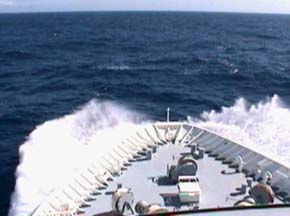 The ship was
running with the prevailing swell, so it gently pitched forward
and aft. Seasickness affected more of the passengers than it had
earlier in the voyage.
The ship was
running with the prevailing swell, so it gently pitched forward
and aft. Seasickness affected more of the passengers than it had
earlier in the voyage.
Debbie had started to succumb to the influenza that had plagued me since our earlier cruise across the passage. She did not feel like rising from bed for most of the day.
With nowhere to land, there was time for a series of lectures during our day at sea. Don Walsh presented the first lecture of the day. He was in the Navy and has a remarkable amount of submersible experience. He was aboard the Trieste when it was the first submersible to reach the bottom of the Marianas Trench in the early sixties.
A Bavarian buffet was served up in the Explorer Lounge that day. I left Debbie dozing in the stateroom and headed up to the buffet on my own. It featured many varieties of pickled herring, hot and cold German potato salads, sausages, and a roast pig.
After the Bavarian buffet, Joann Stock presented a lecture about glaciers and glacial geology. Part way through the lecture, her Kodak Carousel tray jammed on the projector. A passenger in the front row leaned over and started to fiddle with the machine. A few moments later, one of the ship's staff came striding down the aisle to attend to the problem. He apparently knew enough to get the slide tray off the projector, but he had trouble getting the system going again.
After watching them struggle for a little while, I got up and walked down to the front of the auditorium. I pointed out that "I used to sell these things", and asked for the slide tray. I popped the lid on the tray, flipped it over, and rotated the bottom to the start position. I took the lid back off and dropped the two loose slides into the empty slots. I couldn't see well enough to orient the slides, but I figured that there was a slight chance that they would land in the proper orientation and order. I placed the tray on the projector and spun it to the first of the loose slides. It came down upside-down, but we had already seen it. The slide that had jammed came up next. It was even right side up.
Don Wilson of the Smithsonian Institute presented the final lecture of the day. He entitled it Out of Antarctica - Mammalian Radiations. His premise was that most mammal families derived from ancestral mammals on the great southern continent of Gondwanaland. He showed slides of representatives of each mammalian family and discussed the location of the origin of the earliest members of each. He went into extensive detail about the various families of bats. He seemed to have a particular fondness for bats.
After Don Wilson's lecture, Don Walsh came up to me and mentioned that he had overheard me talking about publishing aviation history at breakfast that morning. He explained that he had been one of the co-founders of the American Aviation Historical Society in the fifties. I have been a member of the A.A.H.S. for twenty-eight years. He talked about how he used to shoot pictures of airplanes and mentioned that he has a collection of thousands of airplane photographs.
I took the opportunity to grab my laptop computer from the stateroom, and we went up to the Explorer Lounge. I have all the illustrations for my books about the flying aircraft carriers of the Air Force and the B-52 Stratofortresses used to launch rocket planes at Edwards Air Force Base, as well as the content of my web site, loaded in my laptop. I spent a good part of an hour sharing my pictures with Don. Afterward he thanked me for rekindling his memories of collecting airplane pictures. He commented that he doesn't get to engage in that activity much anymore.
Debbie was still not feeling very mobile, so I went up to the pre-dinner cocktail party by myself. The population in the room was smaller than it had been on previous evenings. While I was nursing my Irish Coffee, Arte Johnson came over to get my address. His wife had her camera out when the iceberg calved in Andvord Bay. They are going to send me prints of the pictures that she took during the ice fall.
Saturday, January 27: Cape Horn, Puerto William
The sky was overcast on Saturday morning when we arrived that the Islas Diego Ramirez, about sixty miles south of Cape Horn. The wind was blowing hard and kicking up a high swell, eliminating any chance of making a Zodiac landing on the islands. Rockhopper Penguins frequented the water around the ship and a few South American Fur Seals porpoised through the swells. I could just make out a Chilean outpost on the largest of the islands through the mist.
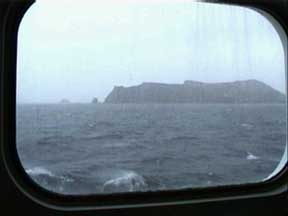 I
observed the scenery through our stateroom window most of the
time that day. I did not brave the cold, wet weather on the
observation deck at all.
I
observed the scenery through our stateroom window most of the
time that day. I did not brave the cold, wet weather on the
observation deck at all.
The ship continued to make its way through heavy seas to Cape Horn. We arrived at the cape in the early afternoon.
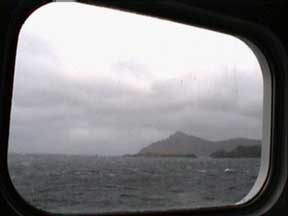 The winds were blowing 45 miles per
hour as we rounded the cape. If we had been in a sailing ship, we
would have been doomed to crash on the rocks, which have been the
site of uncountable shipwrecks. Just for the fun of it, Captain
Notke turned the ship around in a circle and rounded the cape a
second time.
The winds were blowing 45 miles per
hour as we rounded the cape. If we had been in a sailing ship, we
would have been doomed to crash on the rocks, which have been the
site of uncountable shipwrecks. Just for the fun of it, Captain
Notke turned the ship around in a circle and rounded the cape a
second time.
Turning the ship in a circle had the effect of rotating the direction from which the prevailing waves were striking us. First the ship was pitching back and forth with the waves coming from behind. Then it was rolling from side to side as the waves hit us broadside. Then we were pitching again, this time much more quickly as the waves came at us bow on. We went through another phase of more rolling and finished off with the ship pitching. I am sure that the seasick passengers had a special appreciation for that second passage around Cape Horn.
The buildings of the Cape Horn outpost were visible on the crest of a ridge. If we did get to land at Cape Horn, we would have to make a long climb up a wet, wooden stairway to get to the top of the cliff.
A Chilean Navy boat pulled up alongside the ship to offload a local pilot, as required by Chilean law. The navy boat pitched and rolled erratically as the pilot struggled to step across to the Hanseatic. The two boats smacked together repeatedly in the swells.
The winds actually picked up force as the ship entered what should have been a sheltered anchorage. The gale was blowing force 9 on the Beaufort scale. It was gusting to sixty miles per hour. The ship couldn't even drop anchor in the rough seas, so we continued our cruise up the Beagle Channel to Puerto William, Chile.
Dad and Elaine arranged for a dinner party at the "Asian Restaurant" that night. Each evening, the kitchen staff dressed up the Columbus Lounge with Asian décor and turned it into a fancy restaurant. The limited capacity of the lounge meant that reservations were required. The available reservations for the entire trip were quickly booked up, but after Elaine had inquired, they added an extra night of Asian dining the last night of the cruise. Dad and Elaine invited two couples and a father/daughter pair who had been on the Easter Island extension with them, and the tour leaders from the Caltech Associates.
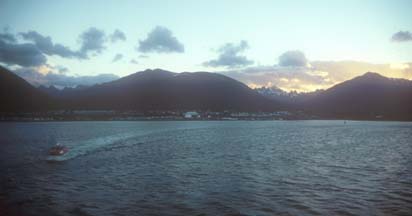 The ship
arrived at Puerto William and dropped anchor as we were
dining.The ship's tender shuttled passengers to the landing.
The ship
arrived at Puerto William and dropped anchor as we were
dining.The ship's tender shuttled passengers to the landing.
Sunday, January 28: Ushuaia
 The Hanseatic docked at Ushuaia early in the morning on Sunday,
January 28. We had time for a leisurely breakfast buffet in the
Marco Polo Restaurant before we disembarked. The ship's staff and
lecturers were waiting at the bottom of the gangway to shake our
hands as we exited the ship. I made a point of distributing my
web site cards with promises to post some of the pictures I had
taken on the expedition. We boarded a trio of buses for the short
ride over to the airport.
The Hanseatic docked at Ushuaia early in the morning on Sunday,
January 28. We had time for a leisurely breakfast buffet in the
Marco Polo Restaurant before we disembarked. The ship's staff and
lecturers were waiting at the bottom of the gangway to shake our
hands as we exited the ship. I made a point of distributing my
web site cards with promises to post some of the pictures I had
taken on the expedition. We boarded a trio of buses for the short
ride over to the airport.
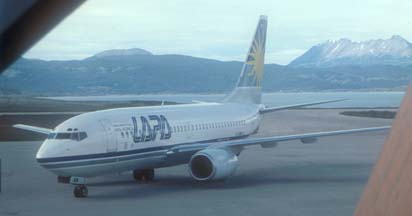 Our plane departed Ushuaia at about 10:00 A.M. local time. That
is equivalent to 5:00 A.M. in California. Debbie and I landed in
Los Angeles about twenty-seven hours later.
Our plane departed Ushuaia at about 10:00 A.M. local time. That
is equivalent to 5:00 A.M. in California. Debbie and I landed in
Los Angeles about twenty-seven hours later.
Monday, January 29: California
Once we breezed through customs I called Jill on my cell phone to get her to come and pick me up as we had arranged. I walked Debbie part way to the terminal where she had to catch yet another airplane. Then I went back to where I had told Jill to pick me up. It was not a very long wait.
We stopped at a coffee shop in Long Beach on the way back to her house. It was vital to my continued survival. I was severely malnourished, dehydrated and decaffeinated following the grueling series of flights. I wolfed down a chicken fried steak and fried eggs with toast. I washed that down with mass quantities of coffee. Afterward, I felt like a new man.
As I drove my 4Runner up the San Diego Freeway and westward along the Ventura Freeway, I concluded that I really love to drive my own car. I did take a moment to drop off twenty-five rolls of exposed Kodachrome at the Goleta Camera Center along the way. I had the processed slides back within a day of my return.
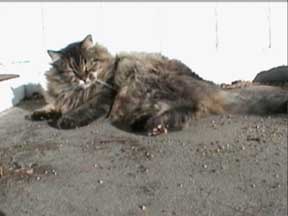 My cat Sally was happy to see me home, again.
She rolled over on her back, stretched, and engaged in lolling
about behavior on the front porch.
My cat Sally was happy to see me home, again.
She rolled over on her back, stretched, and engaged in lolling
about behavior on the front porch.
 Table of
Contents
Table of
Contents Send a message to Brian.